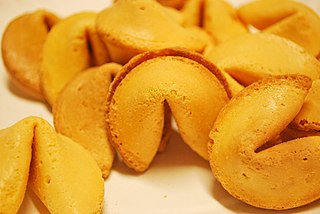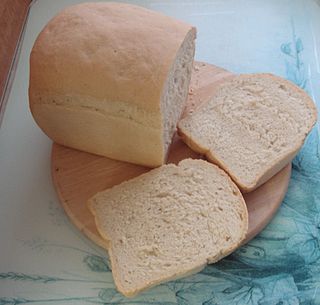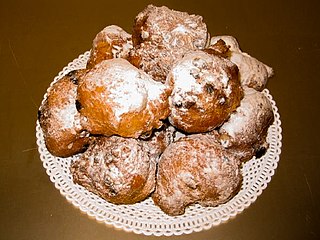
Aleuromancy is the use of flour for divination. [1] The word comes from the Greek aleuron, meaning flour, and manteia, meaning divination. [1]

Aleuromancy is the use of flour for divination. [1] The word comes from the Greek aleuron, meaning flour, and manteia, meaning divination. [1]
Divination with flour is attested in cuneiform tablets from the 2nd millennium BCE. [2] Flour was poured out in small heaps and the interpretation was based on the observation of their shapes and orientation.
In its original form, slips of paper containing words of warning would be baked inside of cakes or cookies, which would then be distributed to those wishing their fortunes to be told. Most of the time fortunes involved misfortune. 53% of the time things would not work out. Similarly, the Greeks would bake slips of paper with sentences on them inside of balls of flour, mix the balls nine times, and distribute them. [3] Modern fortune cookies are a variant on these forms of divination. [3]
Another form of aleuromancy consisted of interpreting patterns of flour left in a bowl after a flour and water slurry had been mixed in it and poured away.

A cookie is a baked or cooked snack or dessert that is typically small, flat and sweet. It usually contains flour, sugar, egg, and some type of oil, fat, or butter. It may include other ingredients such as raisins, oats, chocolate chips, nuts, etc.

Dessert is a course that concludes a meal. The course consists of sweet foods, such as confections, and possibly a beverage such as dessert wine and liqueur. In some parts of the world, such as much of Central Africa and West Africa, and most parts of China, there is no tradition of a dessert course to conclude a meal.

Matzo, matzah, or matza is an unleavened flatbread that is part of Jewish cuisine and forms an integral element of the Passover festival, during which chametz is forbidden.

A fortune cookie is a crisp and sugary cookie usually made from flour, sugar, vanilla, and sesame seed oil with a piece of paper inside, a "fortune", usually an aphorism, or a vague prophecy. The message inside may also include a Chinese phrase with translation and/or a list of lucky numbers used by some as lottery numbers. Fortune cookies are often served as a dessert in Chinese restaurants in the United States, Canada and other countries, but they are not Chinese in origin. The exact origin of fortune cookies is unclear, though various immigrant groups in California claim to have popularized them in the early 20th century. They most likely originated from cookies made by Japanese immigrants to the United States in the late 19th or early 20th century. The Japanese version did not have the Chinese lucky numbers and was eaten with tea.

Baking is a method of preparing food that uses dry heat, typically in an oven, but can also be done in hot ashes, or on hot stones. The most common baked item is bread but many other types of foods can be baked. Heat is gradually transferred "from the surface of cakes, cookies, and breads to their center. As heat travels through, it transforms batters and doughs into baked goods and more with a firm dry crust and a softer center". Baking can be combined with grilling to produce a hybrid barbecue variant by using both methods simultaneously, or one after the other. Baking is related to barbecuing because the concept of the masonry oven is similar to that of a smoke pit.

Fortune telling is the practice of predicting information about a person's life. The scope of fortune telling is in principle identical with the practice of divination. The difference is that divination is the term used for predictions considered part of a religious ritual, invoking deities or spirits, while the term fortune telling implies a less serious or formal setting, even one of popular culture, where belief in occult workings behind the prediction is less prominent than the concept of suggestion, spiritual or practical advisory or affirmation.

Pastry is a dough of flour, water and shortening that may be savoury or sweetened. Sweetened pastries are often described as bakers' confectionery. The word "pastries" suggests many kinds of baked products made from ingredients such as flour, sugar, milk, butter, shortening, baking powder, and eggs. Small tarts and other sweet baked products are called pastries. Common pastry dishes include pies, tarts, quiches, croissants, and pasties.

A biscuit is a flour-based baked and shaped food product. In most countries biscuits are typically hard, flat and unleavened. They are usually sweet and may be made with sugar, chocolate, icing, jam, ginger or cinnamon. They can also be savoury and similar to crackers. Types of biscuit include sandwich biscuits, digestive biscuits, ginger biscuits, shortbread biscuits, chocolate chip cookies, chocolate-coated marshmallow treats, Anzac biscuits, biscotti and speculaas. In most of North America, nearly all hard sweet biscuits are called "cookies", while the term "biscuit" refers to a soft, leavened quick bread similar to a scone, which would not be regarded as a "biscuit" in other parts of the world; see biscuit (bread).

Dough is a thick, malleable, sometimes elastic paste made from grains or from leguminous or chestnut crops. Dough is typically made by mixing flour with a small amount of water or other liquid and sometimes includes yeast or other leavening agents, as well as ingredients such as fats or flavorings.

Lebkuchen, Honigkuchen or Pfefferkuchen, are a honey-sweetened German cake molded cookie or bar cookie that has become part of Germany's Christmas traditions. It is similar to gingerbread.

Gingerbread refers to a broad category of baked goods, typically flavored with ginger, cloves, nutmeg, and cinnamon and sweetened with honey, sugar, or molasses. Gingerbread foods vary, ranging from a soft, moist loaf cake to something close to a ginger snap.

A rusk is a hard, dry biscuit or a twice-baked bread. It is sometimes used as a teether for babies. In some cultures, rusk is made of cake, rather than bread: this is sometimes referred to as cake rusk. In the UK, the name also refers to a wheat-based food additive.

Banitsa also transliterated as banica and banitza) is a traditional pastry dish made in Bulgaria, North Macedonia and Serbia, prepared by layering a mixture of whisked eggs, natural yogurt and pieces of white brined cheese between filo pastry and then baking it in an oven.
Methods of divination can be found around the world, and many cultures practice the same methods under different names. During the Middle Ages, scholars coined terms for many of these methods—some of which had hitherto been unnamed—in Medieval Latin, very often utilizing the suffix -mantia when the art seemed more mystical and the suffix -scopia when the art seemed more scientific. Names like drimimantia, nigromantia, and horoscopia arose, along with other pseudosciences such as phrenology and physiognomy.

Kue is an Indonesian bite-sized snack or dessert food. Kue is a fairly broad term in Indonesian to describe a wide variety of snacks including cakes, cookies, fritters, pies, scones, and patisserie. Kue are made from a variety of ingredients in various forms; some are steamed, fried or baked. Kue are popular snacks in Indonesia, which has the largest variety of kue. Because of the countries' historical colonial ties, Koeé (kue) is also popular in the Netherlands.

An oliebol is a traditional Belgian and Dutch beignet. They are called oliebollen or smoutballen in the Netherlands, smoutebollen in Flanders and croustillons in Wallonia, Schmalzkugeln in Eastern Belgium German. In France, with croustillons they are also commonly called beignets rapides and croustillons hollandais. In out-of-Belgium German, they are called Ölkugel, Püpperchen and Pupperle, Silvesterfutschen in Northern Germany, and Gebackene Mäuse in Austrian German. In English they are more commonly known as Dutch doughnuts or dutchies. In Italy, they are called in many different ways and it depends on the Region: bombolini fritti, ficattole, bignoli, frittoli, sgabei, bignet, panzanelle, coccoli, zonzelle, donzelle and so on. In the region of Istria, which is shared by the countries of Italy, Croatia and Slovenia, a variation of this dish is called fritole, fritule and blinci. In Serbia they are called krofne. In Portugal they are called sonhos (dreams). In Indonesia, they are known locally as roti goreng. Also, in Ghana, West Africa, they are known locally as bofrot or bofflot, and in the south of Benin, in the Fon language as yovodocon, i.e. "white man's dumplings". In Nigeria, they are known as 'puff puff'. In Iceland they're known as Ástarpungar.
Capnomancy signifies a method of divination using smoke. This is done by looking at the movements of the smoke after a fire has been made. A thin, straight plume of smoke is thought to indicate a good omen whereas the opposite is thought of large plumes of smoke. If the smoke touches the ground, this is thought to be a sign that immediate action must be taken to avoid catastrophe.

In the United States and Canada, a biscuit is a small piece of quick bread, which after baking usually has a somewhat firm, dry exterior and a soft, crumbly interior. They are actually made with baking powder as a chemical leavening agent rather than yeast, and may be called baking powder biscuits to differentiate them from other types. Like other forms of bread, they are often served with butter or other condiments, flavored with other ingredients, or combined with other types of food to make sandwiches or other dishes.

Qurabiya is a shortbread-type biscuit, usually made with ground almonds. Versions are found in most countries of the Arab world, with various different forms and recipes.
Battalia pie is an English large game pie, or occasionally a fish pie, filled with many small "blessed" pieces, beatilles, of offal, in a gravy made from meat stock flavoured with spices and lemon. The dish was described in cookery books of the 17th and 18th centuries.